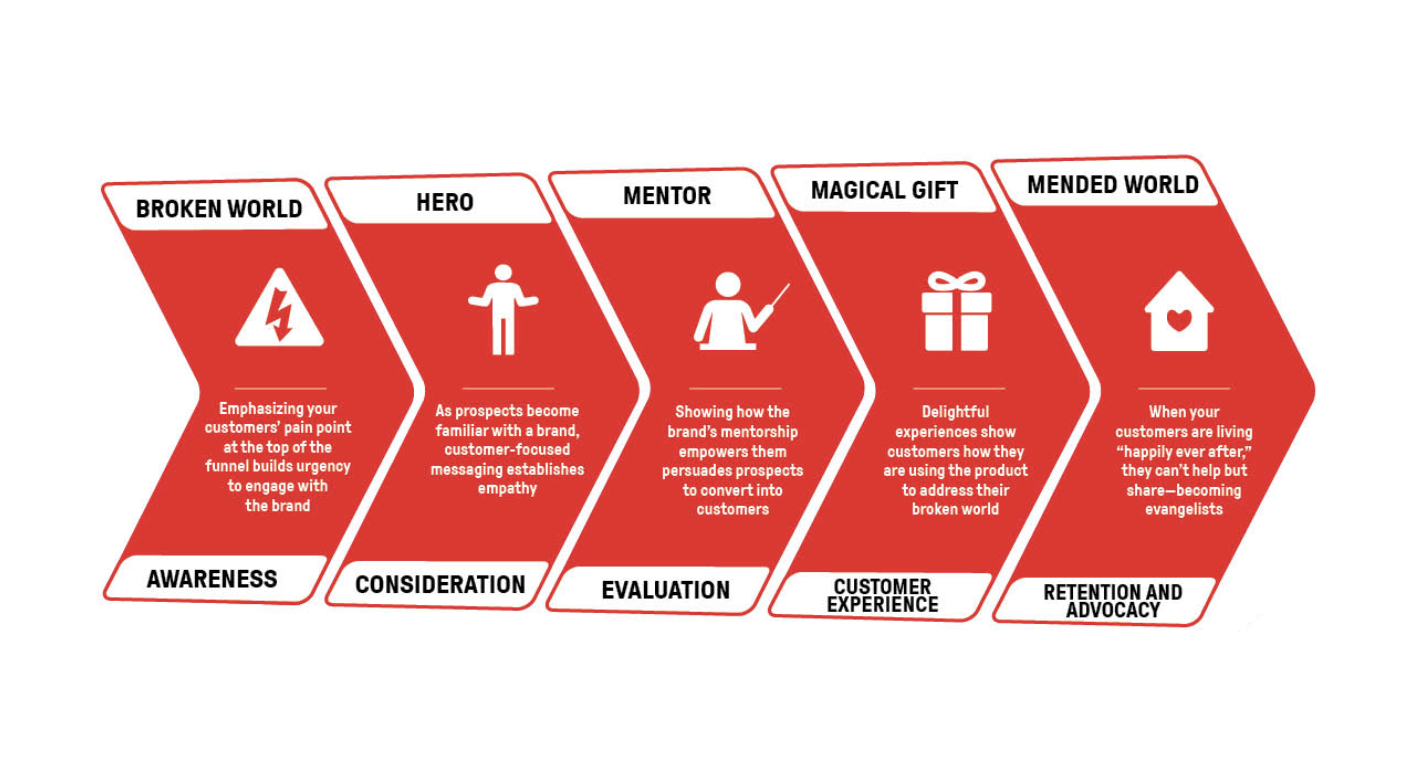
What’s at Stake in Your Sales Funnel?
When customers discover a consistent story of change—they can’t wait to buy
In late 2023, LinkedIn’s B2B institute analyzed 7,046 brands on its platform. It found only 16 percent—16 percent!—whose sales and marketing activities were aligned. Tens of thousands of messages, posts, and ads run every day, and, in almost all cases, they use different messages to target different personas. The research is unambiguous: when sales and marketing are on the same page, sellers are more likely (between 15 and 56 percent) to connect with their audience.
That 16 percent should be enough to stop any sales or marketing leader in their tracks. Weinberg went so far as to call it “horrific” and “terrifying.” When the positive impact of aligning a brand’s sales and marketing is so obvious, why are so few doing it?
Likely because it’s more than one problem to solve. Customer journeys are more complex than ever. Harvard Business Review reports that customers “may be better informed than ever, but CEB research shows that they’re deeply uncertain and stressed. Buying complex solutions … has never been easy. But with a wealth of data on any solution, a raft of stakeholders involved in each purchase, and an ever-expanding array of options, more and more deals bog down or even halt altogether.”
Aligning sales and marketing requires a clear view of the customer journey from start to finish. Both groups—and other teams that support them such as product or outside agencies—need to understand which audiences need to be reached when, and how the brand’s message applies to each. The more complex the journey, the more essential simplicity is: one strategic narrative and framework applied across every stage of the sales funnel.
Customer journeys don’t get much more complex than Redis’. The brand initially came to market as an open-source database where it built a fervent community among developers. When the company launched an enterprise offering in 2017, it had open-source deployments in most of the Fortune 500, but only one paying customer.
Deals had stalled: Redis’ funnel was optimized for the technical user that fueled open-source adoption. Shifting an enterprise’s database structure requires buy-in from a VP-level champion and a final decision in the C-suite—audiences that don’t resonate with dense messaging about technical features. To rethink its customer journey, Redis had to move away from leading with product details such as database caches and instead define a single narrative relevant to each buyer that could carry them through the funnel.
This narrative—the foundation of an efficient funnel—is the story of the customer, a big change in their world, and how the brand guides them through the obstacles they must overcome to navigate this change.
Woden aligns its customers’ strategic narrative with the Hero’s Journey narrative arc. This structure has underpinned the most enduring messages in human history. Its structure is also an asset: it forces brands to develop succinct messaging and reach points of alignment on what really matters to the customer—creating the alignment LinkedIn’s research so often found lacking.
The Hero’s Journey also mirrors every customer’s journey. When a brand defines its story in this way, it gains a blueprint for how their story creates a funnel that customers want to progress through.
The brand story should be built around a big, meaningful change in the world that has real stakes for everyone involved. This is the story’s inciting action. Addressing this problem forms the underlying “plot” of the brand story.
The narrative reveals to the customer that things were once one way, and now they’re very different—and that this change will create winners and losers in the world, their organization and for the buyer individually.
In complex B2B sales, framing the story around this market shift is more effective than solving for “pain points.” Customers can be afflicted by any number of pain points. Brands trying to address them on an individual customer basis create the kind of confusion that clogs sales funnels.
Instead, by seeing each pain point as one of many obstacles along the customer’s path in their journey, each person communicating with the customer has a common framework for why and how they must be solved—and where to go after.
Redis identified the big shift in their market as: “Businesses are more digital today than ever before. They need to build, deploy, and run real-time services in order to stay ahead of the curve. The notion of real-time is not just a nice-to-have anymore. It’s an expectation.” Redis is clear with their audience that there will be two types of companies going forward: those who leverage data in real-time (winners) and those who do not (losers).
This change is mapped to challenges at the existential, organizational, and individual levels of the buyer. An existential problem defines real stakes obvious to everyone. The threats at an organizational level align each buyer’s incentives—which are also addressed in the story to motivate them to move toward a solution. And for each individual buyer, the organizational threats play out in a way specific to their role. The clear hierarchy of these challenges creates alignment across personas and even within the market as the brand is built.
Want to learn more about Redis’ journey to becoming an essential brand? Download a case study on their transformation here.
That market shift is paired with a statement of belief for the brand. This belief serves as the “moral” of the story—the lesson each audience should learn from interacting with the brand This approach provides both simplicity and consistency.
Redis’ story is built on the belief that: “The companies that run fastest run Redis.” That belief can then be shared differently with all buyers—in-memory database speeds for the technical buyer, speed-to-market for the champion, and speed of (company-wide) digital transformation for the C-suite—but any time they are in a room together, they all know Redis means speed.
To pull buyers through the customer journey efficiently, every interaction must be consistent—which requires the alignment LinkedIn found lacking—and simple enough that each stakeholder inside the customer is equally aligned and can be motivated to engage. Each element of the strategic narrative works to do exactly that.

Awareness (top of the funnel) messaging is built around the problems that afflict the world—the shift that puts the story in motion. When the brand asserts to its customers that their world has changed in a meaningful way, it establishes trust: either the customer has already identified this shift and is grateful for an ally to face it alongside, or the shift is new information to the customer, in which case the brand is offering new value and education.
As part of the awareness stage, the market shift must be connected to the impact it will have on the organization. These first two activities can be used in a brand-building approach by marketing or in demand generation—all before a rep enters the conversation. When a prospect engages at this point they already have a sense of urgency, and then the rep can tailor their conversation to the final piece: how that applies to each individual persona’s role inside the buyer.
This creates a seamless transition into the next stage of the funnel, consideration. Here, the story shifts to the buyer to build empathy. It aligns with the discovery activities conducted by the sales team. Good discovery determines whether the prospective customer aligns with the protagonist of the strategic narrative. And in cases where the fit is tight, the audience will see messaging (including on the website) that feels like it’s speaking directly to them.
And then finally as the sale moves into an evaluation phase, the brand asserts its credibility as a mentor or guide. The brand here serves as a source of expertise and wisdom—and maintains a focus on how it will empower the customer to overcome the challenges they face. This is the funnel state where product details should be introduced. Waiting until late in the funnel ensures the buyer is emotionally committed to overcoming the challenges in front of them. It also contextualizes the product as a tool provided by a credible mentor—instead of a standalone set of features and benefits.
Brands like Redis have used a narrative-driven approach to keep them invested and engaged in complex B2B sales. They empower their customers to advocate with a simple story they can own across the organization. When the funnel is built off the narrative, buyers discover new information about their world, themselves, and the seller. New chapters unfold as they progress through a defined sales process built for people like them. Although B2B buyers can often be treated as rational buyers, they are just as emotional as any other human.
When Redis implemented its strategic narrative it had one paid customer. As of late 2023, the company’s valuation is nearly $5 billion.
Redis’ story gave them a framework to talk about their product in a way that aligned all buyers and decision-makers around a single view of the world and belief around how to adapt to it. The right strategic narrative sets a company’s team in motion to reach the right buyers and make their brand essential.
Ed Lynes is the managing partner at Woden. Read our extensive guide on how to craft your organization’s narrative, or send us an email at connect@wodenworks.com to uncover what makes you essential.


